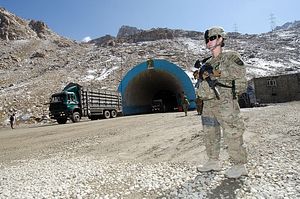A marvel of Soviet engineering when it was first opened in 1964, the Salang Pass tunnel remains the major artery in Afghanistan’s sparse transportation network. The tunnel cuts through the Hindu Kush and connects Kabul to northern Afghanistan via a mostly two-lane highway that winds through dangerous switchbacks high in mountains.
“But if it is Afghanistan’s main economic artery, the Salang Tunnel is in desperate need of bypass surgery,” Nathan Hodge wrote for the Wall Street Journal last year.
The World Bank is set to attempt that surgery, approving a $250 million grant Tuesday to help Afghanistan improve roads crossing the Hindu Kush, particularly the Salang Pass road and tunnel. What sets the “Trans-Hindukush Road Connectivity Project” apart is its inclusion of upgrades to a secondary crossing between Baghlan and Bamiyan.
The Salang highway climbs north from Kabul and links the capital to the entire north of the country. At its highest, the road is over 11,000 feet up in mountains and enters a 1.6 mile-long tunnel. The tunnel was constructed to handle 1,000 vehicles a day. The World Bank estimates that between 5,000 and 9,000 vehicles pass through each day and modern vehicles are heavier than those the road was originally built to accommodate. Additionally, trucks with tire chains or spiked wheels–necessary to stay on the winding, icy road–shred stop-gap asphalt fixes.
And then there’s the wait. In a 2012 NPR report, Sean Carberry wrote that the lines to enter the tunnel “often stretch up to 10 miles on either side.” Not only is getting to the tunnel dangerous but the interior is nightmare, packed with trucks and badly ventilated it’s a disaster waiting to happen, again. In 1982, hundreds of Soviet soldiers died in an accident in the tunnel–some accounts point to a fuel truck explosion and fire while the official Soviet accounts blame carbon monoxide poisoning, due to idling vehicles in the tunnel.
The World Bank notes in project documents that “several expensive repairs during the past 25 years have all been short-lived” due to continued use of the road in winter by overloaded trucks and reluctance to shut the tunnel for extended periods to make full repairs to the concrete surface and the drainage systems.
The full road, 7 meters wide with one lane in each direction, is absolutely vital to Afghanistan’s fragile economy. “A single road closure on the Salang Pass… can cause price swings in Kabul, as some traders hoard fuel and drive up the cost of gasoline and heating oil,” Hodge noted and the World Bank agrees, commenting in project documents that “effects of road closures are immediately felt in Kabul, where prices for some commodities such as fuel may rise by 30 percent after two or three days of road closure. It has been estimated that the costs of such closures is about US$2.0 million per day.”
It comes as no surprise then that the Afghan government has been reluctant to shut the road for repairs–no matter how desperately needed.
That’s where the secondary crossing comes in. According to the World Bank release, the plan is to upgrade the Baghlan to Bamiyan road from its current unpaved state. At present the road handles about 800 vehicles a day, and while a longer trip north the road is not at as high an altitude, assuaging the significant avalanche and rockslide risk of the Salang Pass route. If the Baghlan to Bamiyan road can be significantly improved, it may allow much-needed closure and overhaul of the Salang Pass.
The World Bank estimates the project could take seven years to implement and that, even if successful, maintenance of the road will prove a difficult task. “The problem of truck overloading and excessive use of snow chains remains unresolved until today,” the World Bank notes. And while a number of development agencies have worked to help improve the capacity of the the Afghan Ministry of Public Works “there is a general lack of a maintenance culture which has resulted in premature deterioration of road and other infrastructure.”
It will be a herculean task to repair the Salang Pass road and another to maintain it.

































